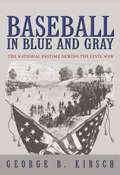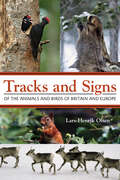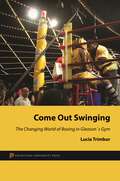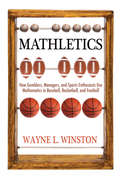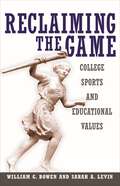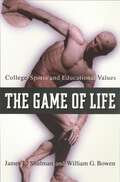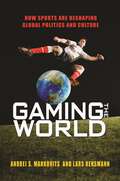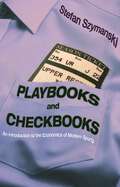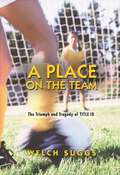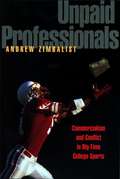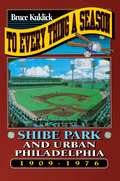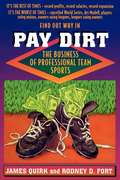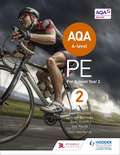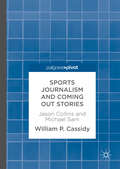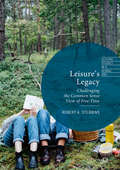- Table View
- List View
Baseball in Blue and Gray: The National Pastime during the Civil War (PDF)
by George B. KirschDuring the Civil War, Americans from homefront to battlefront played baseball as never before. While soldiers slaughtered each other over the country's fate, players and fans struggled over the form of the national pastime. George Kirsch gives us a color commentary of the growth and transformation of baseball during the Civil War. He shows that the game was a vital part of the lives of many a soldier and civilian--and that baseball's popularity had everything to do with surging American nationalism. By 1860, baseball was poised to emerge as the American sport. Clubs in northeastern and a few southern cities played various forms of the game. Newspapers published statistics, and governing bodies set rules. But the Civil War years proved crucial in securing the game's place in the American heart. Soldiers with bats in their rucksacks spread baseball to training camps, war prisons, and even front lines. As nationalist fervor heightened, baseball became patriotic. Fans honored it with the title of national pastime. War metaphors were commonplace in sports reporting, and charity games were scheduled. Decades later, Union general Abner Doubleday would be credited (wrongly) with baseball's invention. The Civil War period also saw key developments in the sport itself, including the spread of the New York-style of play, the advent of revised pitching rules, and the growth of commercialism. Kirsch recounts vivid stories of great players and describes soldiers playing ball to relieve boredom. He introduces entrepreneurs who preached the gospel of baseball, boosted female attendance, and found new ways to make money. We witness bitterly contested championships that enthralled whole cities. We watch African Americans embracing baseball despite official exclusion. And we see legends spring from the pens of early sportswriters. Rich with anecdotes and surprising facts, this narrative of baseball's coming-of-age reveals the remarkable extent to which America's national pastime is bound up with the country's defining event.
Baseball in Blue and Gray: The National Pastime during the Civil War
by George B. KirschDuring the Civil War, Americans from homefront to battlefront played baseball as never before. While soldiers slaughtered each other over the country's fate, players and fans struggled over the form of the national pastime. George Kirsch gives us a color commentary of the growth and transformation of baseball during the Civil War. He shows that the game was a vital part of the lives of many a soldier and civilian--and that baseball's popularity had everything to do with surging American nationalism. By 1860, baseball was poised to emerge as the American sport. Clubs in northeastern and a few southern cities played various forms of the game. Newspapers published statistics, and governing bodies set rules. But the Civil War years proved crucial in securing the game's place in the American heart. Soldiers with bats in their rucksacks spread baseball to training camps, war prisons, and even front lines. As nationalist fervor heightened, baseball became patriotic. Fans honored it with the title of national pastime. War metaphors were commonplace in sports reporting, and charity games were scheduled. Decades later, Union general Abner Doubleday would be credited (wrongly) with baseball's invention. The Civil War period also saw key developments in the sport itself, including the spread of the New York-style of play, the advent of revised pitching rules, and the growth of commercialism. Kirsch recounts vivid stories of great players and describes soldiers playing ball to relieve boredom. He introduces entrepreneurs who preached the gospel of baseball, boosted female attendance, and found new ways to make money. We witness bitterly contested championships that enthralled whole cities. We watch African Americans embracing baseball despite official exclusion. And we see legends spring from the pens of early sportswriters. Rich with anecdotes and surprising facts, this narrative of baseball's coming-of-age reveals the remarkable extent to which America's national pastime is bound up with the country's defining event.
Tracks and Signs of the Animals and Birds of Britain and Europe
by Lars-Henrik OlsenThis beautifully illustrated field guide enables you to easily identify the tracks and signs left by a wide variety of mammal and bird species found in Britain and Europe, covering behaviors ranging from hunting, foraging, and feeding to courtship, breeding, and nesting. Introductory chapters offer detailed drawings of footprints and tracks of large and small mammals, which are followed by sections on mammal scat, bird droppings, and the feeding signs of animals on food sources such as nuts, cones, and rose hips. The book then describes specific mammal species, providing information on size, distribution, behavior, habitat, and similar species, as well as more specific detail on tracks and scat. Distribution maps are also included. This indispensable field guide covers 175 species of mammals and birds, and features a wealth of stunning color photos and artwork throughout. Helps you easily identify the tracks and signs of a variety of mammals and birds Covers 175 species Illustrated throughout with photos, drawings, and artwork ncludes informative descriptions of mammal species along with distribution maps
Tracks and Signs of the Animals and Birds of Britain and Europe
by Lars-Henrik OlsenThis beautifully illustrated field guide enables you to easily identify the tracks and signs left by a wide variety of mammal and bird species found in Britain and Europe, covering behaviors ranging from hunting, foraging, and feeding to courtship, breeding, and nesting. Introductory chapters offer detailed drawings of footprints and tracks of large and small mammals, which are followed by sections on mammal scat, bird droppings, and the feeding signs of animals on food sources such as nuts, cones, and rose hips. The book then describes specific mammal species, providing information on size, distribution, behavior, habitat, and similar species, as well as more specific detail on tracks and scat. Distribution maps are also included. This indispensable field guide covers 175 species of mammals and birds, and features a wealth of stunning color photos and artwork throughout. Helps you easily identify the tracks and signs of a variety of mammals and birds Covers 175 species Illustrated throughout with photos, drawings, and artwork ncludes informative descriptions of mammal species along with distribution maps
Come Out Swinging: The Changing World of Boxing in Gleason's Gym (PDF)
by Lucia TrimburGleason's Gym is the last remaining institution of New York's Golden Age of boxing. Jake LaMotta, Muhammad Ali, Hector Camacho, Mike Tyson--the alumni of Gleason's are a roster of boxing greats. Founded in the Bronx in 1937, Gleason's moved in the mid-1980s to what has since become one of New York's wealthiest residential areas--Brooklyn's DUMBO. Gleason's has also transformed, opening its doors to new members, particularly women and white-collar men. Come Out Swinging is Lucia Trimbur's nuanced insider's account of a place that was once the domain of poor and working-class men of color but is now shared by rich and poor, male and female, black and white, and young and old. Come Out Swinging chronicles the everyday world of the gym. Its diverse members train, fight, talk, and socialize together. We meet amateurs for whom boxing is a full-time, unpaid job. We get to know the trainers who act as their father figures and mentors. We are introduced to women who empower themselves physically and mentally. And we encounter the male urban professionals who pay handsomely to learn to box, and to access a form of masculinity missing from their office-bound lives. Ultimately, Come Out Swinging reveals how Gleason's meets the needs of a variety of people who, despite their differences, are connected through discipline and sport.
Come Out Swinging: The Changing World of Boxing in Gleason's Gym
by Lucia TrimburGleason's Gym is the last remaining institution of New York's Golden Age of boxing. Jake LaMotta, Muhammad Ali, Hector Camacho, Mike Tyson--the alumni of Gleason's are a roster of boxing greats. Founded in the Bronx in 1937, Gleason's moved in the mid-1980s to what has since become one of New York's wealthiest residential areas--Brooklyn's DUMBO. Gleason's has also transformed, opening its doors to new members, particularly women and white-collar men. Come Out Swinging is Lucia Trimbur's nuanced insider's account of a place that was once the domain of poor and working-class men of color but is now shared by rich and poor, male and female, black and white, and young and old. Come Out Swinging chronicles the everyday world of the gym. Its diverse members train, fight, talk, and socialize together. We meet amateurs for whom boxing is a full-time, unpaid job. We get to know the trainers who act as their father figures and mentors. We are introduced to women who empower themselves physically and mentally. And we encounter the male urban professionals who pay handsomely to learn to box, and to access a form of masculinity missing from their office-bound lives. Ultimately, Come Out Swinging reveals how Gleason's meets the needs of a variety of people who, despite their differences, are connected through discipline and sport.
Mathletics: How Gamblers, Managers, and Sports Enthusiasts Use Mathematics in Baseball, Basketball, and Football
by Wayne L. WinstonMathletics is a remarkably entertaining book that shows readers how to use simple mathematics to analyze a range of statistical and probability-related questions in professional baseball, basketball, and football, and in sports gambling. How does professional baseball evaluate hitters? Is a singles hitter like Wade Boggs more valuable than a power hitter like David Ortiz? Should NFL teams pass or run more often on first downs? Could professional basketball have used statistics to expose the crooked referee Tim Donaghy? Does money buy performance in professional sports? In Mathletics, Wayne Winston describes the mathematical methods that top coaches and managers use to evaluate players and improve team performance, and gives math enthusiasts the practical tools they need to enhance their understanding and enjoyment of their favorite sports--and maybe even gain the outside edge to winning bets. Mathletics blends fun math problems with sports stories of actual games, teams, and players, along with personal anecdotes from Winston's work as a sports consultant. Winston uses easy-to-read tables and illustrations to illuminate the techniques and ideas he presents, and all the necessary math concepts--such as arithmetic, basic statistics and probability, and Monte Carlo simulations--are fully explained in the examples. After reading Mathletics, you will understand why baseball teams should almost never bunt, why football overtime systems are unfair, why points, rebounds, and assists aren't enough to determine who's the NBA's best player--and much, much more. In a new epilogue, Winston discusses the stats and numerical analysis behind some recent sporting events, such as how the Dallas Mavericks used analytics to become the 2011 NBA champions.
Mathletics: How Gamblers, Managers, and Sports Enthusiasts Use Mathematics in Baseball, Basketball, and Football
by Wayne L. WinstonMathletics is a remarkably entertaining book that shows readers how to use simple mathematics to analyze a range of statistical and probability-related questions in professional baseball, basketball, and football, and in sports gambling. How does professional baseball evaluate hitters? Is a singles hitter like Wade Boggs more valuable than a power hitter like David Ortiz? Should NFL teams pass or run more often on first downs? Could professional basketball have used statistics to expose the crooked referee Tim Donaghy? Does money buy performance in professional sports? In Mathletics, Wayne Winston describes the mathematical methods that top coaches and managers use to evaluate players and improve team performance, and gives math enthusiasts the practical tools they need to enhance their understanding and enjoyment of their favorite sports--and maybe even gain the outside edge to winning bets. Mathletics blends fun math problems with sports stories of actual games, teams, and players, along with personal anecdotes from Winston's work as a sports consultant. Winston uses easy-to-read tables and illustrations to illuminate the techniques and ideas he presents, and all the necessary math concepts--such as arithmetic, basic statistics and probability, and Monte Carlo simulations--are fully explained in the examples. After reading Mathletics, you will understand why baseball teams should almost never bunt, why football overtime systems are unfair, why points, rebounds, and assists aren't enough to determine who's the NBA's best player--and much, much more. In a new epilogue, Winston discusses the stats and numerical analysis behind some recent sporting events, such as how the Dallas Mavericks used analytics to become the 2011 NBA champions.
Reclaiming the Game: College Sports and Educational Values
by William G. Bowen Sarah A. Levin James L. Shulman Colin G. Campbell Susanne C. Pichler Martin A. KurzweilIn Reclaiming the Game, William Bowen and Sarah Levin disentangle the admissions and academic experiences of recruited athletes, walk-on athletes, and other students. In a field overwhelmed by reliance on anecdotes, the factual findings are striking--and sobering. Anyone seriously concerned about higher education will find it hard to wish away the evidence that athletic recruitment is problematic even at those schools that do not offer athletic scholarships. Thanks to an expansion of the College and Beyond database that resulted in the highly influential studies The Shape of the River and The Game of Life, the authors are able to analyze in great detail the backgrounds, academic qualifications, and college outcomes of athletes and their classmates at thirty-three academically selective colleges and universities that do not offer athletic scholarships. They show that recruited athletes at these schools are as much as four times more likely to gain admission than are other applicants with similar academic credentials. The data also demonstrate that the typical recruit is substantially more likely to end up in the bottom third of the college class than is either the typical walk-on or the student who does not play college sports. Even more troubling is the dramatic evidence that recruited athletes "underperform:" they do even less well academically than predicted by their test scores and high school grades. Over the last four decades, the athletic-academic divide on elite campuses has widened substantially. This book examines the forces that have been driving this process and presents concrete proposals for reform. At its core, Reclaiming the Game is an argument for re-establishing athletics as a means of fulfilling--instead of undermining--the educational missions of our colleges and universities.
Reclaiming the Game: College Sports and Educational Values
by William G. Bowen Sarah A. Levin James L. Shulman Colin G. Campbell Susanne C. Pichler Martin A. KurzweilIn Reclaiming the Game, William Bowen and Sarah Levin disentangle the admissions and academic experiences of recruited athletes, walk-on athletes, and other students. In a field overwhelmed by reliance on anecdotes, the factual findings are striking--and sobering. Anyone seriously concerned about higher education will find it hard to wish away the evidence that athletic recruitment is problematic even at those schools that do not offer athletic scholarships. Thanks to an expansion of the College and Beyond database that resulted in the highly influential studies The Shape of the River and The Game of Life, the authors are able to analyze in great detail the backgrounds, academic qualifications, and college outcomes of athletes and their classmates at thirty-three academically selective colleges and universities that do not offer athletic scholarships. They show that recruited athletes at these schools are as much as four times more likely to gain admission than are other applicants with similar academic credentials. The data also demonstrate that the typical recruit is substantially more likely to end up in the bottom third of the college class than is either the typical walk-on or the student who does not play college sports. Even more troubling is the dramatic evidence that recruited athletes "underperform:" they do even less well academically than predicted by their test scores and high school grades. Over the last four decades, the athletic-academic divide on elite campuses has widened substantially. This book examines the forces that have been driving this process and presents concrete proposals for reform. At its core, Reclaiming the Game is an argument for re-establishing athletics as a means of fulfilling--instead of undermining--the educational missions of our colleges and universities.
The Game of Life: College Sports and Educational Values
by James L. Shulman William G. BowenThe President of Williams College faces a firestorm for not allowing the women's lacrosse team to postpone exams to attend the playoffs. The University of Michigan loses $2.8 million on athletics despite averaging 110,000 fans at each home football game. Schools across the country struggle with the tradeoffs involved with recruiting athletes and updating facilities for dozens of varsity sports. Does increasing intensification of college sports support or detract from higher education's core mission? James Shulman and William Bowen introduce facts into a terrain overrun by emotions and enduring myths. Using the same database that informed The Shape of the River, the authors analyze data on 90,000 students who attended thirty selective colleges and universities in the 1950s, 1970s, and 1990s. Drawing also on historical research and new information on giving and spending, the authors demonstrate how athletics influence the class composition and campus ethos of selective schools, as well as the messages that these institutions send to prospective students, their parents, and society at large. Shulman and Bowen show that athletic programs raise even more difficult questions of educational policy for small private colleges and highly selective universities than they do for big-time scholarship-granting schools. They discover that today's athletes, more so than their predecessors, enter college less academically well-prepared and with different goals and values than their classmates--differences that lead to different lives. They reveal that gender equity efforts have wrought large, sometimes unanticipated changes. And they show that the alumni appetite for winning teams is not--as schools often assume--insatiable. If a culprit emerges, it is the unquestioned spread of a changed athletic culture through the emulation of highly publicized teams by low-profile sports, of men's programs by women's, and of athletic powerhouses by small colleges. Shulman and Bowen celebrate the benefits of collegiate sports, while identifying the subtle ways in which athletic intensification can pull even prestigious institutions from their missions. By examining how athletes and other graduates view The Game of Life--and how colleges shape society's view of what its rules should be--Bowen and Shulman go far beyond sports. They tell us about higher education today: the ways in which colleges set policies, reinforce or neglect their core mission, and send signals about what matters.
The Game of Life: College Sports and Educational Values
by James L. Shulman William G. BowenThe President of Williams College faces a firestorm for not allowing the women's lacrosse team to postpone exams to attend the playoffs. The University of Michigan loses $2.8 million on athletics despite averaging 110,000 fans at each home football game. Schools across the country struggle with the tradeoffs involved with recruiting athletes and updating facilities for dozens of varsity sports. Does increasing intensification of college sports support or detract from higher education's core mission? James Shulman and William Bowen introduce facts into a terrain overrun by emotions and enduring myths. Using the same database that informed The Shape of the River, the authors analyze data on 90,000 students who attended thirty selective colleges and universities in the 1950s, 1970s, and 1990s. Drawing also on historical research and new information on giving and spending, the authors demonstrate how athletics influence the class composition and campus ethos of selective schools, as well as the messages that these institutions send to prospective students, their parents, and society at large. Shulman and Bowen show that athletic programs raise even more difficult questions of educational policy for small private colleges and highly selective universities than they do for big-time scholarship-granting schools. They discover that today's athletes, more so than their predecessors, enter college less academically well-prepared and with different goals and values than their classmates--differences that lead to different lives. They reveal that gender equity efforts have wrought large, sometimes unanticipated changes. And they show that the alumni appetite for winning teams is not--as schools often assume--insatiable. If a culprit emerges, it is the unquestioned spread of a changed athletic culture through the emulation of highly publicized teams by low-profile sports, of men's programs by women's, and of athletic powerhouses by small colleges. Shulman and Bowen celebrate the benefits of collegiate sports, while identifying the subtle ways in which athletic intensification can pull even prestigious institutions from their missions. By examining how athletes and other graduates view The Game of Life--and how colleges shape society's view of what its rules should be--Bowen and Shulman go far beyond sports. They tell us about higher education today: the ways in which colleges set policies, reinforce or neglect their core mission, and send signals about what matters.
Gaming the World: How Sports Are Reshaping Global Politics and Culture
by Andrei S. Markovits Lars RensmannProfessional sports today have truly become a global force, a common language that anyone, regardless of their nationality, can understand. Yet sports also remain distinctly local, with regional teams and the fiercely loyal local fans that follow them. This book examines the twenty-first-century phenomenon of global sports, in which professional teams and their players have become agents of globalization while at the same time fostering deep-seated and antagonistic local allegiances and spawning new forms of cultural conflict and prejudice. Andrei Markovits and Lars Rensmann take readers into the exciting global sports scene, showing how soccer, football, baseball, basketball, and hockey have given rise to a collective identity among millions of predominantly male fans in the United States, Europe, and around the rest of the world. They trace how these global--and globalizing--sports emerged from local pastimes in America, Britain, and Canada over the course of the twentieth century, and how regionalism continues to exert its divisive influence in new and potentially explosive ways. Markovits and Rensmann explore the complex interplay between the global and the local in sports today, demonstrating how sports have opened new avenues for dialogue and shared interest internationally even as they reinforce old antagonisms and create new ones. Gaming the World reveals the pervasive influence of sports on our daily lives, making all of us citizens of an increasingly cosmopolitan world while affirming our local, regional, and national identities.
Gaming the World: How Sports Are Reshaping Global Politics and Culture
by Andrei S. Markovits Lars RensmannProfessional sports today have truly become a global force, a common language that anyone, regardless of their nationality, can understand. Yet sports also remain distinctly local, with regional teams and the fiercely loyal local fans that follow them. This book examines the twenty-first-century phenomenon of global sports, in which professional teams and their players have become agents of globalization while at the same time fostering deep-seated and antagonistic local allegiances and spawning new forms of cultural conflict and prejudice. Andrei Markovits and Lars Rensmann take readers into the exciting global sports scene, showing how soccer, football, baseball, basketball, and hockey have given rise to a collective identity among millions of predominantly male fans in the United States, Europe, and around the rest of the world. They trace how these global--and globalizing--sports emerged from local pastimes in America, Britain, and Canada over the course of the twentieth century, and how regionalism continues to exert its divisive influence in new and potentially explosive ways. Markovits and Rensmann explore the complex interplay between the global and the local in sports today, demonstrating how sports have opened new avenues for dialogue and shared interest internationally even as they reinforce old antagonisms and create new ones. Gaming the World reveals the pervasive influence of sports on our daily lives, making all of us citizens of an increasingly cosmopolitan world while affirming our local, regional, and national identities.
Playbooks and Checkbooks: An Introduction to the Economics of Modern Sports
by Stefan SzymanskiWhat economic rules govern sports? How does the sports business differ from other businesses? Playbooks and Checkbooks takes a fascinating step-by-step look at the fundamental economic relationships shaping modern sports. Focusing on the ways that the sports business does and does not overlap with economics, the book uncovers the core paradox at the heart of the sports industry. Unlike other businesses, the sports industry would not survive if competitors obliterated each other to extinction, financially or otherwise--without rivals there is nothing to sell. Playbooks and Checkbooks examines how this unique economic truth plays out in the sports world, both on and off the field. Noted economist Stefan Szymanski explains how modern sporting contests have evolved; how sports competitions are organized; and how economics has guided antitrust, monopoly, and cartel issues in the sporting world. Szymanski considers the motivation provided by prize money, uncovers discrepancies in players' salaries, and shows why the incentive structure for professional athletes encourages them to cheat through performance-enhancing drugs and match fixing. He also explores how changes in media broadcasting allow owners and athletes to play to a global audience, and why governments continue to publicly fund sporting events such as the Olympics, despite almost certain financial loss. Using economic tools to reveal the complex arrangements of an industry, Playbooks and Checkbooks illuminates the world of sports through economics, and the world of economics through sports.
A Place on the Team: The Triumph and Tragedy of Title IX (PDF)
by Welch SuggsA Place on the Team is the inside story of how Title IX revolutionized American sports. The federal law guaranteeing women's rights in education, Title IX opened gymnasiums and playing fields to millions of young women previously locked out. Journalist Welch Suggs chronicles both the law's successes and failures-the exciting opportunities for women as well as the commercial and recruiting pressures of modern-day athletics. Enlivened with tales from Suggs's reportage, the book clears up the muddle of interpretation and opinion surrounding Title IX. It provides not only a lucid description of how courts and colleges have read (and misread) the law, but also compelling portraits of the people who made women's sports a vibrant feature of American life. What's more, the book provides the first history of the law's evolution since its passage in 1972. Suggs details thirty years of struggles for equal rights on the playing field. Schools dragged their feet, offering token efforts for women and girls, until the courts made it clear that women had to be treated on par with men. Those decisions set the stage for some of the most celebrated moments in sports, such as the Women's World Cup in soccer and the Women's Final Four in NCAA basketball. Title IX is not without its critics. Wrestlers and other male athletes say colleges have cut their teams to comply with the law, and Suggs tells their stories as well. With the chronicles of Pat Summitt, Anson Dorrance, and others who shaped women's sports, A Place on the Team is a must-read not only for sports buffs but also for parents of every young woman who enters the arena of competitive sports.
Unpaid Professionals: Commercialism and Conflict in Big-Time College Sports
by Andrew ZimbalistBig-time college sports embodies the ideals of amateurism and provides an important complement to university education. Or so its apologists would have us believe. As Andrew Zimbalist shows in this unprecedented analysis, college sports is really a massively commercialized industry based on activities that are often irrelevant and even harmful to education. Zimbalist combines groundbreaking empirical research and a talent for storytelling to provide a firm, factual basis for the many arguments that currently rage about the goals, history, structure, incentive system, and legal architecture of college sports. He paints a picture of a system in desperate need of reform and presents bold recommendations to chart a more sensible future. Zimbalist begins by showing that today's problems are nothing new--that schools have been consumed for more than a century by debates about cheating, commercialism, and the erosion of academic standards. He then takes us into the world of the modern student athlete, explaining the incentives that, for example, encourage star athletes to abandon college for the pros, that create such useless courses as "The Theory of Basketball," and that lead students to ignore classes despite the astronomical odds against becoming a professional athlete. Zimbalist discusses the economic and legal aspects of gender equity in college sports. He assesses the economic impact of television and radio contracts and the financial rewards that come from winning major championships. He examines the often harmful effects of corporate sponsorship and shows that, despite such sponsorship, most schools run their athletic programs at a loss. Zimbalist also considers the relevance of antitrust laws to college sports and asks whether student athletes are ultimately exploited by the system. Zimbalist's provocative recommendations include eliminating freshman eligibility for sports, restricting coaches' access to "sneaker money" from corporations, and ending the hypocrisy about professionalism by allowing teams to employ a quota of non-students as well as to receive funding from the pro leagues. A mixture of lively anecdotes, hard economic data, cogent arguments, and clear analysis, Unpaid Professionals will revitalize debate about a subject close to the hearts and minds of millions of Americans.
Hard Ball: The Abuse of Power in Pro Team Sports
by James Quirk Rodney D. FortWhat can possibly account for the strange state of affairs in professional sports today? There are billionaire owners and millionaire players, but both groups are constantly squabbling over money. Many pro teams appear to be virtual "cash machines," generating astronomical annual revenues, but their owners seem willing to uproot them and move to any city willing to promise increased profits. At the same time, mayors continue to cook up "sweetheart deals" that lavish benefits on wealthy teams while imposing crushing financial hardships on cities that are already strapped with debt. To fans today, professional sports teams often look more like professional extortionists.In Hard Ball, James Quirk and Rodney Fort take on a daunting challenge: explaining exactly how things have gotten to this point and proposing a way out. Both authors are professional economists who specialize in the economics of sports. Their previous book, Pay Dirt: The Business of Professional Team Sports, is widely acknowledged as the Bible of sports economics. Here, however, they are writing for sports fans who are trying to make sense out of the perplexing world of pro team sports. It is not money, in itself, that is the cause of today's problems, they assert. In fact, the real problem stems from one simple fact: pro sports are monopolies that are fully sanctioned by the U.S. government. Eliminate the monopolies, say Quirk and Fort, and all problems can be solved. If the monopolies are allowed to persist, so will today's woes.The authors discuss all four major pro team sports: baseball, football, basketball, and hockey. Hard Ball is filled with anecdotes, case studies, and factual information that are brought together here for the first time. Quirk and Fort devote chapters to the main protagonists in the pro sports saga--media, unions, players, owners, politicians, and leagues--before they offer their own prescription for correcting the ills that afflict sports today. The result is an engaging and persuasive book that is sure to be widely read, cited, and debated. It is essential reading for every fan.
Home Team: Professional Sports and the American Metropolis
by Michael N. DanielsonMost books that study professional sports concentrate on teams and leagues. In contrast, Home Team studies the connections between professional team sports in North America and the places where teams play. It examines the relationships between the four major professional team sports--baseball, basketball, football, and hockey--and the cities that attach their names, their hearts, and their increasing amount of tax dollars to big league teams. From the names on their uniforms to the loyalties of their fans, teams are tied to the places in which they play. Nonetheless, teams, like other urban businesses, are affected by changes in their environments--like the flight of their customers to suburbs and changes in local political climates. In Home Team, professional sports are scrutinized in the larger context of the metropolitan areas that surround and support them. Michael Danielson is particularly interested in the political aspects of the connections between professional sports teams and cities. He points out that local and state governments are now major players in the competition for franchises, providing increasingly lavish publicly funded facilities for what are, in fact, private business ventures. As a result, professional sports enterprises, which have insisted that private leagues rather than public laws be the proper means of regulating games, have become powerful political players, seeking additional benefits from government, often playing off one city against another. The wide variety of governmental responses reflects the enormous diversity of urban and state politics in the United States and in the Canadian cities and provinces that host professional teams. Home Team collects a vast amount of data, much of it difficult to find elsewhere, including information on the relocation of franchises, expansion teams, new leagues, stadium development, and the political influence of the rich cast of characters involved in the ongoing contests over where teams will play and who will pay. Everyone who is interested in the present condition and future prospects of professional sports will be captivated by this informative and provocative new book.
To Every Thing a Season: Shibe Park and Urban Philadelphia, 1909-1976
by Bruce KuklickShibe Park was demolished in 1976, and today its site is surrounded by the devastation of North Philadelphia. Kuklick, however, vividly evokes the feelings people had about the home of the Philadelphia Athletics and later the Phillies.
Pay Dirt: The Business of Professional Team Sports
by James Quirk Rodney D. FortWhy would a Japanese millionaire want to buy the Seattle Mariners baseball team, when he has admitted that he has never played in or even seen a baseball game? Cash is the answer: major league baseball, like professional football, basketball, and hockey, is now big business with the potential to bring millions of dollars in profits to owners. Not very long ago, however, buying a sports franchise was a hazardous investment risked only by die-hard fans wealthy enough to lose parts of fortunes made in other businesses. What forces have changed team ownership from sports-fan folly to big-business savvy? Why has The Wall Street Journal become popular reading in pro sports locker rooms? And why are sports pages now dominated by economic clashes between owners and players, cities with franchises and cities without them, leagues and players' unions, and team lawyers and players' lawyers? In answering these questions, James Quirk and Rodney Fort have written the most complete book on the business and economics of professional sports, past and present. Pay Dirt offers a wealth of information and analysis on the reserve clause, salary determination, competitive balance in sports leagues, the market for franchises, tax sheltering, arenas and stadiums, and rival leagues. The authors present an abundance of historical material, much of it new, including team ownership histories and data on attendance, TV revenue, stadium and arena contracts, and revenues and costs. League histories, team statistics, stories about players and owners, and sports lore of all kinds embellish the work. Quirk and Fort are writing for anyone interested in sports in the 1990s: players, players' agents, general managers, sportswriters, and, most of all, sports fans.
AQA PE For A-level Year 2 (PDF)
by Carl Atherton Symond Burrows Ross Howitt Sue YoungExam Board: AQA Level: AS/A-level Subject: PE First Teaching: September 2016 First Exam: June 2018 Inspire, motivate and give confidence to your students with AQA PE for A Level Book 2. This reliable and accessible textbook will offer your students comprehensive support for both the academic and practical elements of the course. This Student's Book has been selected for AQA's official approval process. - Key questions to direct thinking and help students focus on the key points - Diagrams to aid understanding - Summaries to aid revision and help students access the main points - Extension questions, stimulus material and suggestions for further reading to stretch, challenge and encourage independent thinking and a deeper understanding - Definition of key terms - again to aid and consolidate understanding of technical vocabulary and concepts - Activities to build conceptual understanding and sound knowledge and understanding, analysis, evaluation and application skills Contents: Section 1 Applied Anatomy and Physiology - Sue Young 1. 1 Energy systems Section 2 Skill acquisition - Carl Atherton 2. 1 Information processing Section 3: Exercise physiology - Sue Young 3. 1 Injury prevention and the rehabilitation of injury Section 4: Biomechanical movement - Sue Young 4. 1 Linear motion 4. 2 Angular motion 4. 3 Projectile motion 4. 4 Fluid mechanics Section 5: Sport psychology - Carl Atherton 5. 1 Psychological factors that can influence an individual in physical activities Section 6 Sport and society and the role of technology in physical activity and sport - Symond Burrows 6. 1 Concepts of physical activity and sport 6. 2 Development of elite performers in sport 6. 3 Ethics in sport 6. 4 Violence in sport 6. 5 Drugs in sport 6. 6 Sport and the law 6. 7 Impact of commercialisation on physical activity and sport and the relationship 6. 8 The role of technology in physical activity and sport Section 7 Assessment - Ross Howitt 7. 1 Tackling the A-level exam 7. 2 Tackling the non-examined assessment
Sports Journalism and Coming Out Stories: Jason Collins and Michael Sam
by William P. CassidyThis book examines how sports journalists covered the historic coming out stories of National Basketball Association (NBA) veteran Jason Collins and football All-American Michael Sam in the context of sports’ “toy department” reputation as a field whose standards are often criticized as lacking in rigor and depth compared to other forms of journalism. Employing a media sociology approach, reporting about Collins and Sam is addressed in the book via three content analysis studies and interviews with two prominent sports journalists. An overview of other pertinent research is provided along with a detailed account of both athletes’ stories. This work should appeal to readers interested in sports journalism, the role of sport in society, and media coverage of gay professional athletes.
Sports Journalism and Coming Out Stories: Jason Collins and Michael Sam
by William P. CassidyThis book examines how sports journalists covered the historic coming out stories of National Basketball Association (NBA) veteran Jason Collins and football All-American Michael Sam in the context of sports’ “toy department” reputation as a field whose standards are often criticized as lacking in rigor and depth compared to other forms of journalism. Employing a media sociology approach, reporting about Collins and Sam is addressed in the book via three content analysis studies and interviews with two prominent sports journalists. An overview of other pertinent research is provided along with a detailed account of both athletes’ stories. This work should appeal to readers interested in sports journalism, the role of sport in society, and media coverage of gay professional athletes.
Leisure’s Legacy: Challenging the Common Sense View of Free Time
by Robert A. StebbinsThis book illustrates how leisure, as with other complex ideas that hold currency in today’s world, suffers at the level of common sense, due to a combination of oversimplification, moral depreciation, and even lack of recognition.Leisure’s modern legacy is both profound and immense, as a product of approximately 45 years of steady research, application and theory development. The common sense view of free-time activities, therefore, can and should be challenged. Stebbins provides this confrontation by tackling four particular themes: that gatekeepers within the institutions of higher education and funding agencies for research often fail to attach adequate resources to the idea of leisure; that the general population are guided by certain common sense definitions and largely unaware of how an informed view of free time could be beneficial; that practitioners within certain fields continue to refuse to engage with the idea of leisure despite its benefit for their clients; and that the weak reception of the science of leisure within mainstream social sciences suggests a similarly warped understanding of how people use their free time.Leisure’s Legacy will be of interest to scholars of Leisure Studies and all those wishing to learn more about the vital importance of leisure in modern Western society.
